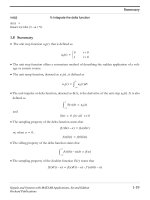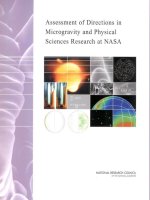Photochemistry and photophysics concepts, research, applications
Bạn đang xem bản rút gọn của tài liệu. Xem và tải ngay bản đầy đủ của tài liệu tại đây (8.37 MB, 502 trang )
www.pdfgrip.com
Vincenzo Balzani,
Paola Ceroni, and
Alberto Juris
Photochemistry and Photophysics
www.pdfgrip.com
Related Titles
Medintz, I., Hildebrandt, N. (eds.)
Likhtenshtein, G. I.
FRET Făorster Resonance
Energy Transfer
Solar Energy Conversion
From Theory to Applications
2013
Chemical Aspects
2012
ISBN: 978-3-527-32874-1
ISBN: 978-3-527-32816-1
Sauer, M., Hofkens, J., Enderlein, J.
Valeur, B., Berberan-Santos, M. N.
Molecular Fluorescence
Principles and Applications
Second Edition
Handbook of Fluorescence
Spectroscopy and Imaging
From Single Molecules to Ensembles
2011
ISBN: 978-3-527-31669-4
2012
ISBN: 978-3-527-32837-6 (Hardcover)
ISBN: 978-3-527-32846-8 (Softcover)
Albini, A., Fagnoni, M. (eds.)
Fouassier, J.-P., Lalev´ee, J.
Handbook of Synthetic
Photochemistry
Photoinitiators for Polymer
Synthesis
2010
ISBN: 978-3-527-32391-3
Scope, Reactivity, and Efficiency
2012
ISBN: 978-3-527-33210-6
www.pdfgrip.com
Vincenzo Balzani,
Paola Ceroni, and
Alberto Juris
Photochemistry and Photophysics
Concepts, Research, Applications
www.pdfgrip.com
The Authors
Prof. Vincenzo Balzani
University of Bologna
‘‘G. Ciamician’’ Department of Chemistry
Via Selmi 2
40126 Bologna
Italy
Prof. Paola Ceroni
University of Bologna
‘‘G. Ciamician’’ Department of Chemistry
Via Selmi 2
40126 Bologna
Italy
Prof. Alberto Juris
University of Bologna
‘‘G. Ciamician’’ Department of Chemistry
Via Selmi 2
40126 Bologna
Italy
All books published by Wiley-VCH are
carefully produced. Nevertheless, authors,
editors, and publisher do not warrant the
information contained in these books,
including this book, to be free of errors.
Readers are advised to keep in mind that
statements, data, illustrations, procedural
details or other items may inadvertently be
inaccurate.
Library of Congress Card No.: applied for
British Library Cataloguing-in-Publication
Data
A catalogue record for this book is available
from the British Library.
Bibliographic information published by the
Deutsche Nationalbibliothek
The Deutsche Nationalbibliothek
lists this publication in the Deutsche
Nationalbibliografie; detailed bibliographic
data are available on the Internet at
<>.
c 2014 Wiley-VCH Verlag GmbH & Co.
KGaA, Boschstr. 12, 69469 Weinheim,
Germany
All rights reserved (including those of
translation into other languages). No part
of this book may be reproduced in any
form – by photoprinting, microfilm, or any
other means – nor transmitted or translated
into a machine language without written
permission from the publishers. Registered
names, trademarks, etc. used in this book,
even when not specifically marked as such,
are not to be considered unprotected by law.
Print ISBN: 978-3-527-33479-7
ePDF ISBN: 978-3-527-67105-2
ePub ISBN: 978-3-527-67104-5
mobi ISBN: 978-3-527-67103-8
Cover-Design Grafik-Design Schulz,
Fuògăonheim, Germany
Typesetting Laserwords Private Limited,
Chennai, India
Printing and Binding Markono Print Media
Pte Ltd, Singapore
Printed on acid-free paper
www.pdfgrip.com
V
To Carla, Carlo, and Teresa
www.pdfgrip.com
www.pdfgrip.com
VII
Contents
List of Boxes XVII
Preface XIX
Acknowledgments XXV
List of Abbreviations XXVII
1
1.1
1.2
1.3
1.4
1.5
1.6
Introduction 1
Photochemistry and Photophysics in Science and Technology 1
Historical Notes 2
A New Dimension of Chemistry and Physics 3
The Nature of Light 5
Absorption of Light 7
Quantum Yield, Efficiencies, and Excited-State Reactivity 8
References 10
2
2.1
2.2
2.3
2.4
2.5
2.6
2.7
2.7.1
2.7.2
2.7.3
2.8
2.8.1
2.8.2
2.8.3
2.8.4
2.9
2.9.1
Elementary Molecular Orbital Theory 11
Introduction 11
The Hydrogen Atom 11
Polyelectronic Atoms 13
From Atoms to Molecules 17
Electronic Structure of Homonuclear Diatomic Molecules 21
Electronic Structure of Heteronuclear Diatomic Molecules 25
Simple Polyatomic Molecules and Elements of Group Theory 26
Elements of Group Theory 26
Water 29
Ammonia 31
Typical Organic Molecules 33
Methane 33
Ethene 35
Benzene 37
Formaldehyde 39
Transition Metal Complexes 41
General Concepts 41
www.pdfgrip.com
VIII
Contents
2.9.2
Typical Metal Complexes
References 52
3
3.1
3.1.1
3.1.2
3.1.3
3.1.4
3.1.5
Light Absorption and Excited-State Deactivation 55
Light Absorption 55
Selection Rules 57
Symmetry Selection Rules 58
Spin Selection Rules 59
The Franck–Condon Principle 60
Visualization of Photochemical Reactions on Potential Energy
Surfaces 62
Jablonski Diagram 64
Excited-State Deactivation 68
Vibrational Relaxation 68
Radiationless Deactivation 68
Radiative Deactivation 71
Radiative Lifetime 72
Chemical Reactions 73
Kinetic Aspects 74
Solvent and Temperature Effects 75
Solvatochromic Shift 75
Crossing of States 77
Temperature Effects on Excited-State Lifetime 79
Thermally Activated Delayed Fluorescence 80
Selected Molecules 81
Oxygen 81
Naphthalene 83
Benzophenone 85
Zinc(II) Tetraphenyl Porphyrin 87
[Cr(en)3 ]3+ 90
[Co(NH3 )6 ]3+ 92
[Ru(bpy)3 ]2+ 94
Semiconductors 96
References 100
3.2
3.3
3.3.1
3.3.2
3.3.3
3.3.4
3.4
3.5
3.6
3.6.1
3.6.2
3.6.3
3.6.4
3.7
3.7.1
3.7.2
3.7.3
3.7.4
3.7.5
3.7.6
3.7.7
3.8
4
4.1
4.2
4.3
4.4
4.4.1
4.4.2
4.4.3
4.4.4
4.4.5
48
Excited States: Physical and Chemical Properties
Excited State as a New Molecule 103
Lifetime 103
Energy 104
Geometry 105
Small Molecules 106
Ethene 107
Ethyne 108
Benzene 109
Formaldehyde 109
www.pdfgrip.com
103
Contents
4.4.6
4.5
4.6
4.7
4.8
Square Planar Metal Complexes
Dipole Moments 112
Electron Transfer 114
Proton Transfer 117
Excimers and Exciplexes 120
References 122
5
5.1
From Molecules to Supramolecular Systems 125
Supramolecular (Multicomponent) Systems and Large
Molecules 125
Electronic Interaction in Mixed-Valence Compounds 127
Electronic Interaction in Donor–Acceptor Complexes 129
Electronic Stimulation and Electronic Interaction in the Excited
State 131
Formation of Excimers and Exciplexes in Supramolecular
Systems 134
References 136
5.2
5.3
5.4
5.5
6
6.1
6.2
6.2.1
6.2.2
6.2.3
6.2.4
6.2.5
6.3
6.4
6.4.1
6.4.2
6.4.2.1
6.4.2.2
6.4.2.3
6.5
6.5.1
6.5.2
6.6
6.7
7
7.1
7.2
111
Quenching and Sensitization Processes in Molecular and
Supramolecular Species 139
Introduction 139
Bimolecular Quenching 140
Stern–Volmer Equation 140
Kinetic Details 143
Static versus Dynamic Quenching 144
Sensitized Processes 145
Spin Considerations 146
Quenching and Sensitization Processes in Supramolecular
Systems 146
Electron-Transfer Kinetics 150
Marcus Theory 150
Quantum Mechanical Theory 153
The Electronic Factor 154
The Nuclear Factor 156
Optical Electron Transfer 156
Energy Transfer 157
Coulombic Mechanism 159
Exchange Mechanism 161
Role of the Bridge 163
Catalyzed Deactivation 164
References 166
Molecular Organic Photochemistry 169
Introduction 169
Alkenes and Related Compounds 169
www.pdfgrip.com
IX
X
Contents
7.2.1
7.2.2
7.2.3
7.2.4
7.2.5
7.2.6
7.2.7
7.3
7.3.1
7.3.2
7.3.3
7.3.4
7.3.5
7.4
7.4.1
7.4.2
7.5
7.5.1
7.5.1.1
7.5.1.2
7.5.2
7.5.3
Basic Concepts 169
Photoisomerization of Double Bonds 170
Electrocyclic Processes 172
Sigmatropic Rearrangements 173
Di-π-Methane Reaction 174
Photocycloaddition Reactions 174
Photoinduced Nucleophile, Proton, and Electron Addition 175
Aromatic Compounds 176
Introduction 176
Photosubstitution 179
Photorearrangement 180
Phototransposition 181
Photocycloadditions 181
Carbonyl Compounds 182
Introduction 182
Photochemical Primary Processes 183
Photochemistry of Other Organic Compounds 185
Nitrogen Compounds 185
Overview 185
Photoisomerization of Azocompounds 186
Saturated Oxygen and Sulfur Compounds 186
Halogen Compounds 187
References 189
8
8.1
8.2
8.3
8.4
8.4.1
8.4.2
8.4.3
8.4.4
8.5
8.5.1
8.5.2
8.5.2.1
8.5.2.2
8.5.2.3
8.5.2.4
8.5.2.5
8.5.3
8.5.4
8.5.5
8.6
Photochemistry and Photophysics of Metal Complexes 191
Metal Complexes 191
Photophysical Properties 191
Photochemical Reactivity 192
Relationships between Electrochemistry and Photochemistry 194
Cobalt (III) Complexes 195
Copper (I) Complexes 196
Ru(II) Polypyridine Complexes 196
Excited-State Redox Potentials 199
Luminescent Metal Complexes 201
Polypyridine Metal Complexes 201
Cyclometallated Complexes 203
Ruthenium Complexes 204
Rhodium Complexes 204
Iridium Complexes 205
Platinum Complexes 207
Orbital Nature of the Emitting Excited State 212
Porphyrin Complexes 213
Chromium (III) Complexes 216
Lanthanoid Complexes 219
Photochemical Processes 223
www.pdfgrip.com
Contents
8.6.1
8.6.1.1
8.6.1.2
8.6.1.3
Types of Photoreactions 223
Photodissociation and Related Reactions 223
Photooxidation–Reduction Reactions 224
Intramolecular Rearrangements 225
References 226
9
Interconversion of Light and Chemical Energy by Bimolecular
Redox Processes 231
Light as a Reactant 231
Light as a Product 232
Conversion of Light into Chemical Energy 233
Chemiluminescence 235
Electrochemiluminescence 235
Light Absorption Sensitizers 237
Light Emission Sensitizers 240
References 242
9.1
9.2
9.3
9.4
9.5
9.6
9.7
10
10.1
10.2
10.3
10.3.1
10.3.2
10.3.2.1
10.3.2.2
10.3.2.3
10.3.2.4
10.4
10.4.1
10.4.2
10.4.3
10.4.4
10.5
10.5.1
10.5.2
10.5.3
10.6
10.6.1
10.6.2
10.6.3
10.6.4
10.6.5
Light-Powered Molecular Devices and Machines 245
Molecules, Self-Organization, and Covalent Synthetic
Design 245
Light Inputs and Outputs: Reading, Writing, and Erasing 246
Molecular Devices for Information Processing 247
Photochromic Systems as Molecular Memories 247
Molecular Logics 249
Luminescent Sensors as Simple Logic Gates 250
AND Logic Gate 251
XOR Logic Gate with an Intrinsic Threshold Mechanism 251
Encoding and Decoding 253
Molecular Devices Based on Energy Transfer 255
Wires 255
Switches 257
Plug/Socket Systems 258
Light-Harvesting Antennas 259
Molecular Devices Based on Electron Transfer 260
Wires 260
Switches 263
Extension Cables 265
Light-Powered Molecular Machines 268
Basic Remarks 268
The Role of Light 268
Rotary Motors Based on cis–trans Photoisomerization 269
Linear Motions: Molecular Shuttles and Related Systems 271
Photocontrolled Valves, Boxes, and Related Systems 275
References 276
www.pdfgrip.com
XI
XII
Contents
11
11.1
11.2
11.2.1
11.2.2
11.2.2.1
11.2.2.2
11.2.3
11.3
11.3.1
11.3.2
11.3.3
11.3.4
11.4
12
12.1
12.1.1
12.1.2
12.1.3
12.1.4
12.2
12.2.1
12.2.1.1
12.2.1.2
12.2.1.3
12.2.2
12.2.2.1
12.2.2.2
12.2.2.3
12.2.2.4
12.2.2.5
12.2.2.6
12.2.2.7
12.3
12.3.1
12.3.1.1
12.3.1.2
12.3.2
12.3.2.1
12.3.2.2
12.3.2.3
Natural and Artificial Photosynthesis 281
Energy for Spaceship Earth 281
Natural Photosynthesis 284
Light Harvesting: Absorption and Energy Transfer 285
Photoinduced Electron Transfer Leading to Charge Separation 285
Bacterial Photosynthesis 285
Green Plants Photosynthesis: Photosystem II 287
Efficiency of Photosynthesis 288
Artificial Photosynthesis 290
Artificial Antenna 293
Artificial Reaction Centers 296
Coupling Artificial Antenna and Reaction Center 299
Coupling One-Photon Charge Separation with Multielectron Water
Splitting 301
Water Splitting by Semiconductor Photocatalysis 302
References 304
Experimental Techniques 309
Apparatus 309
Light Sources 309
Monochromators, Filters, and Solvents 317
Cells and Irradiation Equipment 319
Detectors 321
Steady-State Absorption and Emission Spectroscopy 323
Absorption Spectroscopy 323
Instrumentation 324
Qualitative and Quantitative Applications 325
Sample Measurement 325
Emission Spectroscopy 326
Instrumentation 326
Emission Spectra 328
Excitation Spectra 329
Presence of Spurious Bands 330
Quantitative Relationship between Luminescence Intensity and
Concentration 331
Stern–Volmer Luminescence Quenching 332
Emission Quantum Yields 333
Time-Resolved Absorption and Emission Spectroscopy 335
Transient Absorption Spectroscopy 335
Transient Absorption with Nanosecond Resolution 335
Transient Absorption with Femtosecond Resolution 337
Emission Lifetime Measurements 338
Single Flash 338
Gated Sampling 339
Upconversion Techniques 339
www.pdfgrip.com
Contents
12.3.2.4
12.3.2.5
12.3.2.6
12.3.2.7
12.4
12.4.1
12.4.2
12.5
12.5.1
12.5.2
12.5.2.1
12.5.2.2
12.5.2.3
12.6
12.6.1
12.6.1.1
12.6.1.2
12.6.2
12.6.3
12.6.4
Single-Photon Counting 341
Data Analysis 342
Phase Shift 343
Luminescence Lifetime Standards 345
Absorption and Emission Measurements with Polarized Light 346
Linear Dichroism 346
Luminescence Anisotropy 347
Reaction Quantum Yields and Actinometry 349
Reaction Quantum Yields 349
Actinometry 350
Potassium Ferrioxalate 351
Potassium Reineckate 352
Azobenzene 353
Other Techniques 353
Photothermal Methods 353
Photoacoustic Spectroscopy 354
Photorefractive Spectroscopy 355
Single-Molecule Spectroscopy 357
Fluorescence Correlation Spectroscopy 358
X-ray Techniques 360
References 361
13
13.1
13.2
13.2.1
13.2.2
13.3
13.4
13.4.1
13.4.2
13.5
13.5.1
13.5.2
13.5.3
13.5.4
13.6
13.6.1
13.6.2
13.6.3
13.6.4
13.7
13.7.1
13.7.2
13.8
Light Control of Biologically Relevant Processes 365
Introduction 365
Vision 365
Basic Principle 365
Primary Photochemical Events 367
Light, Skin, and Sunscreens 367
Photochemical Damage in Living Systems 369
Photochemical Damage to DNA 369
Photochemical Damage to Proteins 369
Therapeutic Strategies Using Light 370
Phototherapy 370
Photochemotherapy of Psoriasis 370
Photodynamic Therapy 371
Photocontrolled Delivery 373
Photocatalysis in Environmental Protection 375
Principles 375
Solar Disinfection (SODIS) 375
Photoassisted Fenton Reaction 376
Heterogeneous Photocatalysis 376
DNA Photocleavage and Charge Transport 377
Photocleaving Agents of Nucleic Acid 377
Photoinduced Electron-Transfer Processes in DNA 378
Fluorescence 379
www.pdfgrip.com
XIII
XIV
Contents
13.9
Bioluminescence
References 380
379
14
14.1
14.2
14.3
14.3.1
14.3.2
14.3.3
14.3.4
14.3.5
14.3.6
14.3.7
14.4
14.5
14.5.1
14.5.2
14.6
14.6.1
14.6.2
14.6.3
14.7
14.7.1
14.7.2
14.7.3
14.8
14.8.1
14.8.2
14.8.3
14.8.4
14.8.5
14.8.6
14.8.7
14.8.8
14.9
14.9.1
14.9.2
14.9.3
14.9.4
Technological Applications of Photochemistry and Photophysics
Introduction 385
Photochromism 385
Luminescent Sensors 388
Principles 388
Amplifying Signal 389
Wind Tunnel Research 389
Thermometers 391
Measuring Blood Analytes 393
Detecting Warfare Chemical Agents 395
Detecting Explosives 397
Optical Brightening Agents 399
Atmospheric Photochemistry 400
Natural Processes Involving Oxygen 400
Ozone Hole 401
Solar Cells 402
Inorganic Photovoltaic (PV) Cells 402
Organic Solar Cells (OSCs) 403
Dye-Sensitized Solar Cells (DSSCs) 405
Electroluminescent Materials 407
Light-Emitting Diodes (LEDs) 407
Organic Light-Emitting Diodes (OLEDs) 407
Light-Emitting Electrochemical Cells (LECs) 409
Polymers and Light 411
Photopolymerization 411
Photodegradation 411
Stabilization of Commercial Polymers 412
Photochemical Curing 413
Other Light-Induced Processes 413
Photolithography 414
Stereolithography 415
Holography 416
Light for Chemical Synthesis 417
Photochlorination of Polymers 418
Synthesis of Caprolactam 418
Synthesis of Vitamins 418
Perfumes 419
References 420
15
15.1
15.2
Green (Photo)Chemistry 425
Definition, Origins, and Motivations 425
Photochemistry for Green Chemical Synthesis 426
www.pdfgrip.com
385
Contents
15.3
15.3.1
15.3.2
15.4
15.4.1
15.4.2
15.4.3
15.4.4
15.5
15.6
Photocatalysis 428
Heterogeneous Photocatalysis 428
Homogeneous Photocatalysis 429
Photocatalysis in Synthesis 429
Alkanes 430
Alkenes 430
Alkynes 432
Sulfides 432
Photocatalytic Pollution Remediation 433
Use of Solar Energy in Green Synthesis 434
References 436
16
16.1
16.2
16.3
Research Frontiers 439
Introduction 439
Aggregation-Induced Emission 439
Phosphorescence from Purely Organic Materials by Crystal
Design 441
Synthesis of a 2D Polymer 443
Photocontrolled Relative Unidirectional Transit of a Nonsymmetric
Molecular Wire through a Molecular Ring 444
Molecular Rotary Motors Powered by Visible Light via Energy
Transfer 445
Cooperation and Interference in Multifunction Compounds 447
Singlet Fission 449
One-Color Photochromic System 452
Photonic Modulation of Electron Transfer with Switchable Phase
Inversion 454
Dye-Sensitized Photoelectrosynthesis Cells (DSPECs) 457
References 459
16.4
16.5
16.6
16.7
16.8
16.9
16.10
16.11
Index
463
www.pdfgrip.com
XV
www.pdfgrip.com
XVII
List of Boxes
Box 2.1:
Box 2.2:
Mathematical Aspects of Group Theory 27
Nd3+ complexes 50
Box 3.1:
Box 3.2:
Box 3.3:
Multiphotonic Processes 66
Solvatochromic Dyes 76
Quantum Dots 99
Box 5.1:
Energy Reservoir 132
Box 6.1:
Box 6.2:
Upconversion by Energy Transfer and Triplet–triplet
Annihilation 147
Photocatalysis 165
Box 7.1:
Box 7.2:
Singlet Oxygen 176
Solid-state Photochemistry 188
Box 8.1:
Box 8.2:
Box 8.3:
Oxidative Addition of Pt(II) Complexes 210
Identification of the Reactive Excited State in Cr(III) Complexes by
Sensitization and Quenching 218
Spin Crossover in [Fe(bpy)3 ]2+ 225
Box 11.1:
Box 11.2:
Box 11.3:
Box 11.4:
Giacomo Ciamician: A Pioneer of Photochemistry 281
The Science of Leaf Color Change [12] 289
Evaluation of Catalyst Efficiency in Photocatalytic Processes 302
Artificial Photosynthesis Versus Photovoltaics 304
Box 12.1:
Lasers 312
www.pdfgrip.com
www.pdfgrip.com
XIX
Preface
And God said: ‘‘Let there be light’’;
And there was light.
And God saw that the light was good.
(Genesis, 1, 3–4)
Photochemistry and photophysics are natural phenomena as old as the world.
Our life depends on photosynthesis, a natural photochemical and photophysical
process. We get information about the surrounding space by photochemical and
photophysical processes that occur in our eyes.
Currently, photochemistry and photophysics represent a modern branch of
science, at the interface between light and matter and at the crossroads of several
disciplines including chemistry, physics, material science, ecology, biology, and
medicine. In our daily life, we are surrounded by products obtained with the aid
of photochemistry and photophysics and by devices that exploit photochemical and
photophysical processes to perform useful functions in a variety of places, from
industries to hospitals.
We are moving toward a future in which energy and information will be
the dominant features of civilization. We will be forced to exploit sunlight as our
ultimate energy source, converting it into useful energy forms by photochemical and
photophysical processes. We will continue to miniaturize devices for information
and communication technology down to the molecular level and we will use, more
and more, light signals to transfer, store, and retrieve information.
The current scientific literature shows that the frontiers of photochemistry
and photophysics continue to expand with the development of new molecules,
new materials, and new processes. There is no doubt that photochemistry and
photophysics will play an increasingly important role in the development of science
and technology.
The number of researchers working in the area of light–matter interaction is
increasing, but several of them did (and still do) not receive appropriate training.
Light is often used in chemical laboratories as a silver bullet reactant to obtain
products unavailable by thermal activation. In general, however, researchers lack
the basis to fully understand how photochemical and photophysical processes can
www.pdfgrip.com
XX
Preface
be exploited for novel, unusual, and unexpected applications in fields such as
energy conversion, information technology, nanotechnology, and medicine.
In the past 5 years, several textbooks and reference books on photochemistry have
been published. However, most of them essentially focus on the photoreactions
of organic molecules. In some textbooks, the fundamental bases of excited-state
properties are confined in a few pages; in others, theoretical aspects are presented
in too much detail, including boring and unnecessary mathematical treatments.
Most of the available books ignore, or barely mention, the photochemical and
photophysical properties of metal complexes, a class of molecules that is attracting
increasing theoretical and applicative interest. No textbook emphasizes the most
recent trends in photochemistry and photophysics, such as information processing
by reading, writing, and erasing molecules with light signals, the capability of
powering and controlling molecular machines by light, the conversion of sunlight
into electrical energy by inorganic and organic solar cells, the recent developments
in the field of light-emitting devices, and the first achievements along the road
toward artificial photosynthesis.
For all these reasons, we felt there was the need for a book capable of (i)
presenting a clear picture of the concepts required to understand the excited
states properties of the most important types of molecules, (ii) showing recent
applications concerning photochemistry and photophysics, and (iii) opening the
eyes of young researchers toward forefront developments or even futuristic visions
of the light–matter interaction.
We believe that this book, which originates from our long experience in teaching
photochemistry and photophysics at the University of Bologna, can be a basic text
for graduate and postgraduate courses because of its balanced content. We feel
that it can also be useful for scientists who desire entering photochemistry and
photophysics research even if they did not have a chance, during their university
training, to get the fundamental bases of this field. Scientists already active in
photochemical and photophysical research may find suggestions to undertake
novel scientific adventures.
Chapters 1–4 of this book deal with fundamental concepts concerning the nature
of light, the principles that govern its interaction with matter, and the formation,
electronic structure, properties, chemical reactivity, and radiative and nonradiative
decay of excited states. Each concept is illustrated making reference to important
classes of molecules. The notion that an excited state is a new chemical species
with its own chemical and physical properties compared with the ground state is
underlined, leading to the conclusion that photochemistry is a new dimension of
chemistry.
Chapter 5 extends the above-mentioned concepts to supramolecular (multicomponent) systems, where a fundamental role is played by structural organization
and component interactions. Chapter 6 illustrates the fundamental concepts and
the theoretical approaches concerning the two most important photochemical
and photophysical processes, namely, energy transfer and photoinduced electron
transfer. Chapter 7 deals with molecular organic photochemistry, illustrating the
main types of reactions of the various families of organic compounds. Chapter 8
www.pdfgrip.com
Preface
is dedicated to the photochemistry and photophysics of metal complexes, with
particular emphasis on the outstanding luminescence properties of some classes of
these compounds. Chapter 9 describes the relationships between photochemical,
photophysical, and electrochemical properties of molecules and shows how these
properties can be exploited for the interconversion between light and chemical
energy. Chapter 10 deals with the hot topic of light-powered molecular devices and
machines. The concepts of exploiting the interaction between molecules and light
to read, write, and erase information are illustrated, together with their application in the field of molecular logics. A variety of molecular devices (e.g., wires,
switches, extension cables, and light-harvesting antennas) based on energy transfer, photoinduced electron transfer or photoisomerization processes are described,
and important examples of light-powered molecular machines (e.g., linear and
rotary motors) are illustrated. Chapter 11 describes the photochemical and photophysical processes taking place in the natural photosynthetic process and the
approaches developed toward artificial photosynthesis, with particular focus on the
photosensitized water splitting process. Chapter 12 offers a detailed presentation
of equipment, techniques, procedures, and reference data concerning photochemical and photophysical experiments, including warnings to avoid mistakes and
misinterpretations.
Chapters 13–16 deal with topics of great current interest. Chapter 13 illustrates
the relationships between light and life, starting from vision and including damages
caused by exposure to UV light, benefits deriving from light-based therapeutic
processes, photocatalysis for environmental protection, fluorescence for labeling
biomolecules, and a brief description of bioluminescence processes. Chapter 14
deals with applications of photochemistry and photophysics, covering a variety
of topics: photochromic compounds, luminescent sensors (including, e.g., their
use in fields as diverse as wind tunnel, thermometers, measuring blood analytes,
detecting explosives and warfare chemical agents), optical brighteners, atmospheric
photochemistry, solar cells (PV, OSC, DSSC), electrochemiluminescent materials
(LED, OLED, LEC), numerous applications concerning the interaction between
polymers and light (e.g., photodegradation, photostabilization, photolithography,
and stereolithography), and the photochemical syntheses of industrial products.
Chapter 15 illustrates the use of light as an ideal reagent for green chemical
synthesis; also described is the extensive use of homogeneous and heterogeneous
photocatalysis for taking advantage of sunlight in laboratory processes as well as
practical applications such as pollution remediation.
After having presented the fundamental concepts of photochemistry and photophysics and described the most important natural and artificial photochemical and
photophysical processes, in Chapter 16 we offer the reader the opportunity to make
acquaintance with forefront research through the discussion of 10 selected topics
taken from the recent literature. The choice of the examples has been based not only
on their intrinsic interest but especially on their educational capacity to illustrate
connections among fundamental photochemical and photophysical concepts.
In several chapters, additional information on some particular topics is presented
in boxes interlaced with the text. An important feature of the book is the abundance
www.pdfgrip.com
XXI
XXII
Preface
of illustrations that are essential for an easier understanding of the concepts
discussed. Several papers reported in the recent literature (up to mid-2013) have
been cited.
Before closing, we would like to express our feeling concerning science, society,
and Earth, the spaceship on which we live. We are concerned about the increasing
consumption of natural resources [1], the climate change [2], the energy crisis [3],
and the degradation of the environment [4–6]. Until now, mankind has taken from
spaceship Earth enormous amounts of resources [7]. We need to reverse this trend
[8]. We need to create new resources. In principle, this is possible by exploiting
the only abundant, inexhaustible, and well-distributed resource on which we can
rely: solar energy. Starting from seawater and the fundamental components of
our atmosphere (nitrogen, oxygen, and carbon dioxide), by means of sunshine, we
need to ‘‘fabricate’’ fuels, electricity, pure water, polymers, food, and other things
we need [9]. Photochemistry and photophysics can help. Maybe future generations
will pay back the Earth with a capital created by human intelligence. We should
not forget, however, that our society is affected by a thread more dangerous than
ecological unsustainability, namely, social unsustainability, which results from the
continuously increasing disparities among people living on different nations as
well as within each nation. Indeed, science can greatly benefit mankind, but science
and technology alone will not take us where we need to go: a fair, open, responsible,
friendly, united, and peaceful society. Responsible scientists, while creating, with
the greatest moral care, new science and technology, should also play an important
role as authoritative, informed, and concerned citizens of planet Earth [10]. They
should teach their students not only to make science but also to distinguish what
is worth making with science. As pointed out by Albert Einstein, ‘‘Concern for
man himself and his fate must always constitute the chief objective of all technological
endeavors … never forget this in the midst of your diagrams and equations.’’ We need
scientists watching that science and technology are used for peace, not for war; for
alleviating poverty, not for maintaining privileges; for reducing, not for increasing
the gap between developed and underdeveloped countries; for protecting, not for
destroying our planet that, beyond any foreseeable development of science, will
remain the only place where mankind can live.
References
UeG7z5tvbpA (accessed 23 September
1. Global Footprint Network
(2011) Annual Report 2011,
/>index.php/GFN/page/annual report 2011/
(accessed 23 September 2013).
2. IPCC (2007) Fourth Assessment
Report: Climate Change (the next
report will appear at the end of 2014),
and data/
publications and data reports.shtml#.
2013).
3. Armaroli, N. and Balzani, V. (2011)
Energy for a Sustainable World: From
the Oil Age to a Sun-Powered Future,
Wiley-VCH Verlag GmbH, Weinheim.
4. Wilson, E.O. (2006) The Creation: An
Appeal to Save Life on Earth, Norton,
New York.
www.pdfgrip.com
Preface
5. Brown, L.R. (2011) World on the Edge:
How to Prevent Environmental and Economic Collapse, Norton, New York.
6. Ehrlich, P.R. and Ehrlich, A.H. (2013)
Can a collapse of global civilization be
avoided? Proc. R. Soc. B, 280, 20122845.
7. Krausmann, F., Erb, K.-H., Gingrich,
S., Haberl, H., Bondeau, A., Gaube, V.,
Lauk, C., Plutzar, C., and Searchinger,
T.D. (2013) Global human appropriation
of net primary production doubled in
the 20th century. Proc. Natl. Acad. Sci.
U.S.A., 110, 10324–9.
8. Roberts, L., Stone, R., and Sugden, A.
(2009) The rise of restoration ecology.
Science, 325, 555.
9. Gray, H.B. (2009) Powering the planet
with solar fuel. Nat. Chem., 1, 7.
10. Balzani, V., Credi, A., and Venturi, M.
(2008) The role of science in our time,
in Molecular Devices and Machines: Concepts and Perspectives for the Nanoworld,
Wiley-VCH Verlag GmbH, Weinheim.
www.pdfgrip.com
XXIII









